Trick or Treaty: Historical Analysis of the Canadian Treaty No. 9
VerifiedAdded on 2022/10/17
|5
|1027
|16
Essay
AI Summary
This essay analyzes the 'Trick or Treaty' assignment, focusing on Treaty No. 9 signed between the Canadian government and Indigenous peoples. The essay examines the reasons behind treaty signings, the impact of the treaty on the Aboriginal community, and the use of deceptive practices during negotiations. It explores the differing interpretations of the treaty, the implications of the oral versus written agreements, and the significance of the commissioner Alexander Morris's statement. The essay highlights the ongoing challenges faced by Indigenous peoples and the need for reconciliation and justice. The location of the treaty area and the historical context are also explored, offering a comprehensive understanding of the treaty's complexities and its lasting consequences.
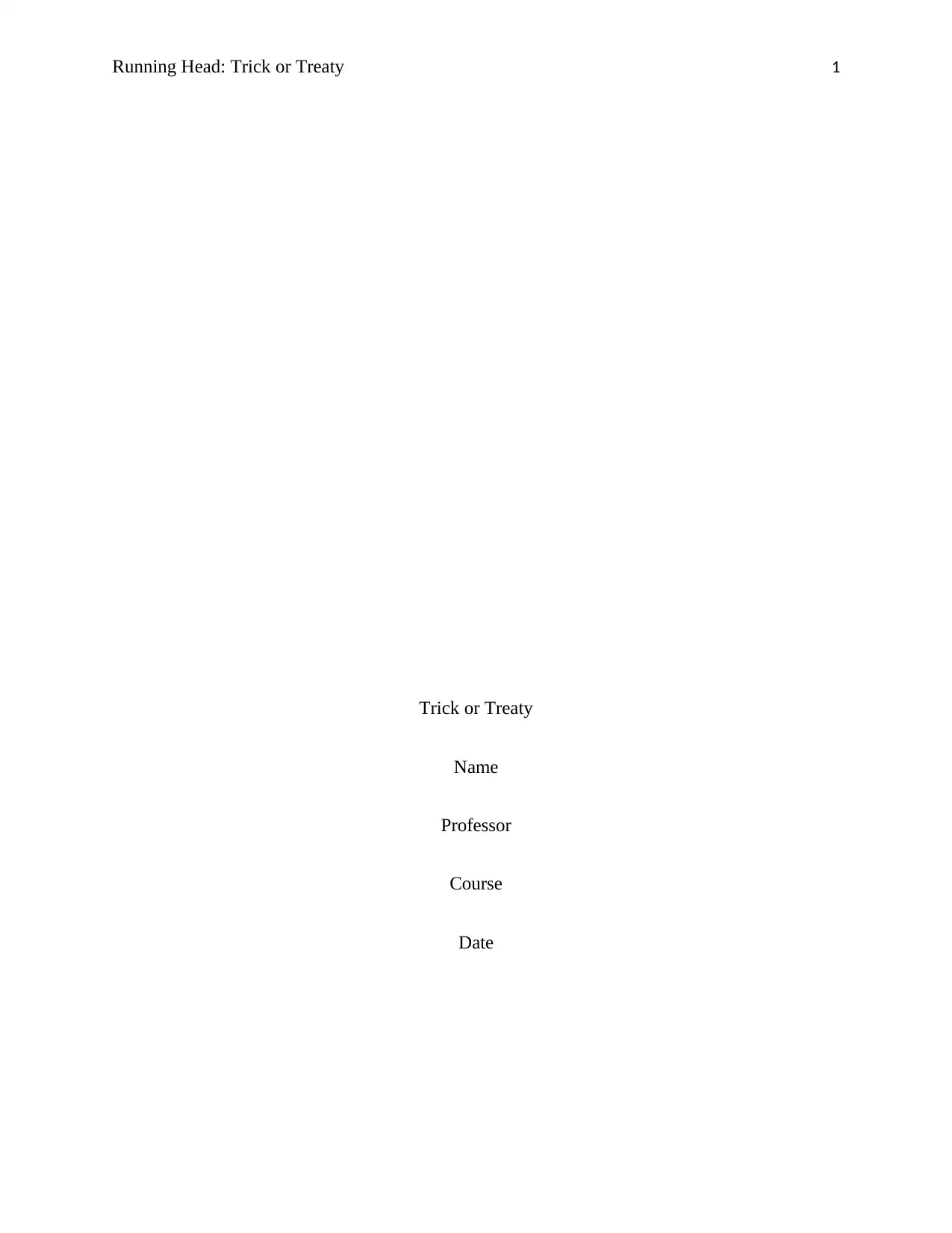
Running Head: Trick or Treaty 1
Trick or Treaty
Name
Professor
Course
Date
Trick or Treaty
Name
Professor
Course
Date
Paraphrase This Document
Need a fresh take? Get an instant paraphrase of this document with our AI Paraphraser
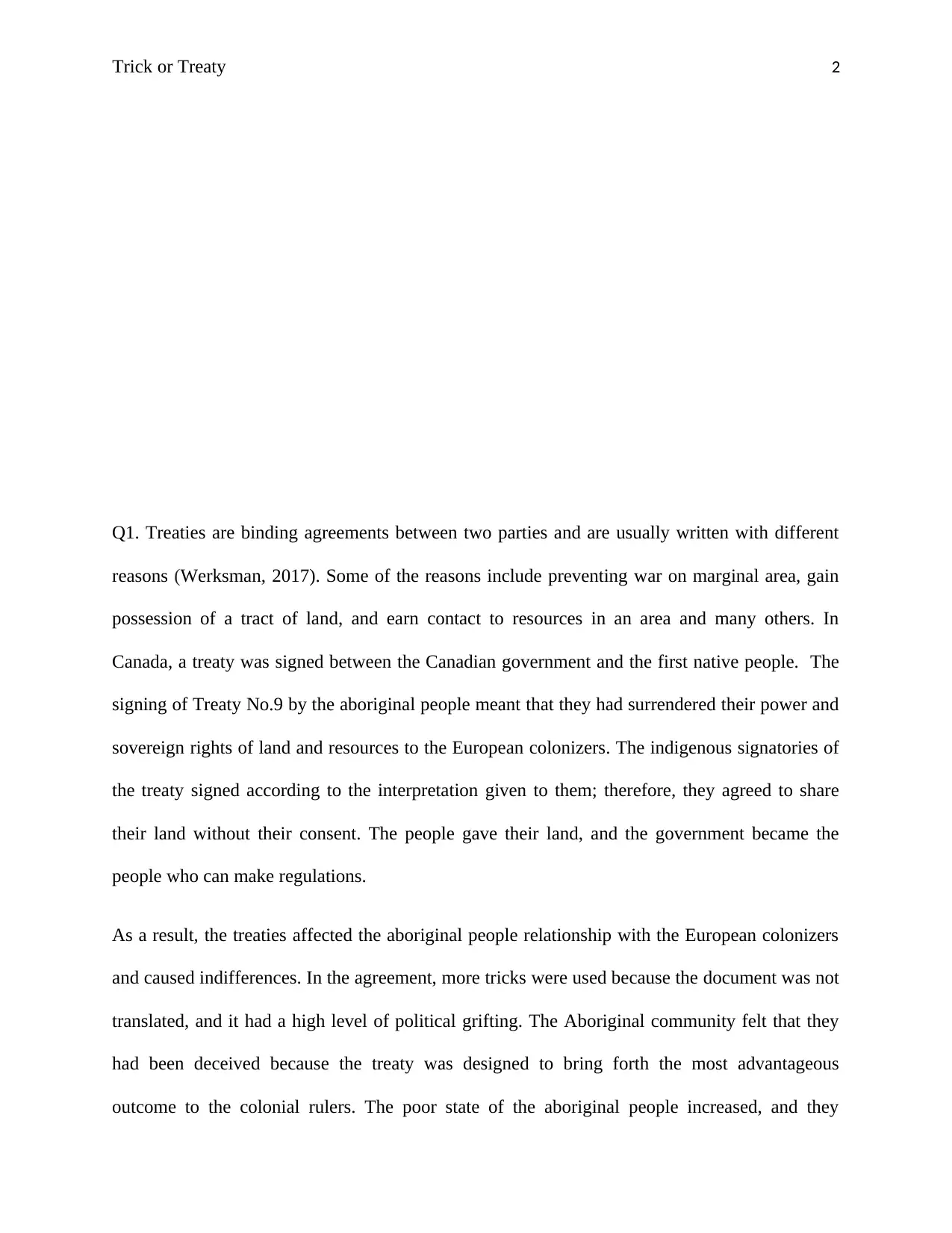
Trick or Treaty 2
Q1. Treaties are binding agreements between two parties and are usually written with different
reasons (Werksman, 2017). Some of the reasons include preventing war on marginal area, gain
possession of a tract of land, and earn contact to resources in an area and many others. In
Canada, a treaty was signed between the Canadian government and the first native people. The
signing of Treaty No.9 by the aboriginal people meant that they had surrendered their power and
sovereign rights of land and resources to the European colonizers. The indigenous signatories of
the treaty signed according to the interpretation given to them; therefore, they agreed to share
their land without their consent. The people gave their land, and the government became the
people who can make regulations.
As a result, the treaties affected the aboriginal people relationship with the European colonizers
and caused indifferences. In the agreement, more tricks were used because the document was not
translated, and it had a high level of political grifting. The Aboriginal community felt that they
had been deceived because the treaty was designed to bring forth the most advantageous
outcome to the colonial rulers. The poor state of the aboriginal people increased, and they
Q1. Treaties are binding agreements between two parties and are usually written with different
reasons (Werksman, 2017). Some of the reasons include preventing war on marginal area, gain
possession of a tract of land, and earn contact to resources in an area and many others. In
Canada, a treaty was signed between the Canadian government and the first native people. The
signing of Treaty No.9 by the aboriginal people meant that they had surrendered their power and
sovereign rights of land and resources to the European colonizers. The indigenous signatories of
the treaty signed according to the interpretation given to them; therefore, they agreed to share
their land without their consent. The people gave their land, and the government became the
people who can make regulations.
As a result, the treaties affected the aboriginal people relationship with the European colonizers
and caused indifferences. In the agreement, more tricks were used because the document was not
translated, and it had a high level of political grifting. The Aboriginal community felt that they
had been deceived because the treaty was designed to bring forth the most advantageous
outcome to the colonial rulers. The poor state of the aboriginal people increased, and they
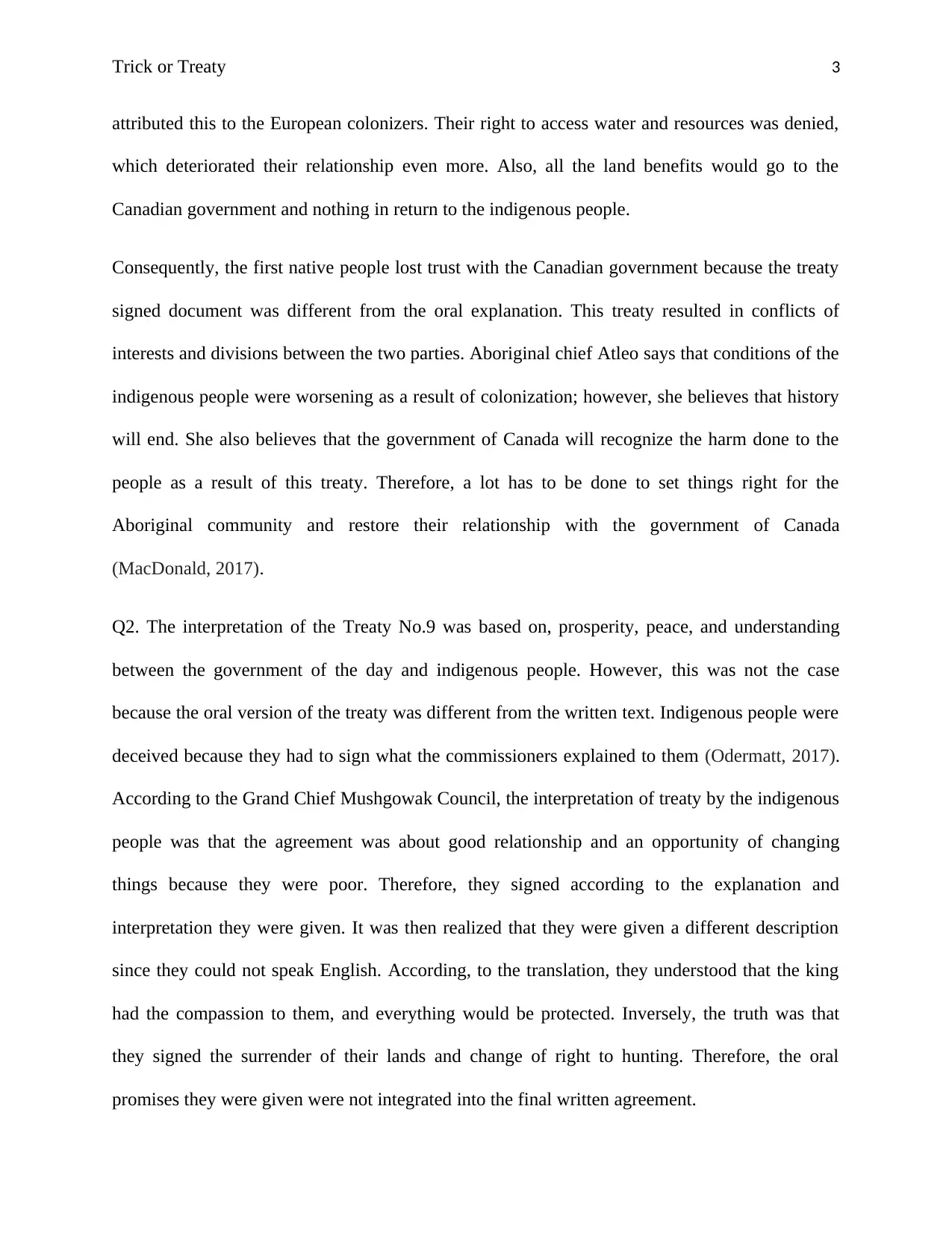
Trick or Treaty 3
attributed this to the European colonizers. Their right to access water and resources was denied,
which deteriorated their relationship even more. Also, all the land benefits would go to the
Canadian government and nothing in return to the indigenous people.
Consequently, the first native people lost trust with the Canadian government because the treaty
signed document was different from the oral explanation. This treaty resulted in conflicts of
interests and divisions between the two parties. Aboriginal chief Atleo says that conditions of the
indigenous people were worsening as a result of colonization; however, she believes that history
will end. She also believes that the government of Canada will recognize the harm done to the
people as a result of this treaty. Therefore, a lot has to be done to set things right for the
Aboriginal community and restore their relationship with the government of Canada
(MacDonald, 2017).
Q2. The interpretation of the Treaty No.9 was based on, prosperity, peace, and understanding
between the government of the day and indigenous people. However, this was not the case
because the oral version of the treaty was different from the written text. Indigenous people were
deceived because they had to sign what the commissioners explained to them (Odermatt, 2017).
According to the Grand Chief Mushgowak Council, the interpretation of treaty by the indigenous
people was that the agreement was about good relationship and an opportunity of changing
things because they were poor. Therefore, they signed according to the explanation and
interpretation they were given. It was then realized that they were given a different description
since they could not speak English. According, to the translation, they understood that the king
had the compassion to them, and everything would be protected. Inversely, the truth was that
they signed the surrender of their lands and change of right to hunting. Therefore, the oral
promises they were given were not integrated into the final written agreement.
attributed this to the European colonizers. Their right to access water and resources was denied,
which deteriorated their relationship even more. Also, all the land benefits would go to the
Canadian government and nothing in return to the indigenous people.
Consequently, the first native people lost trust with the Canadian government because the treaty
signed document was different from the oral explanation. This treaty resulted in conflicts of
interests and divisions between the two parties. Aboriginal chief Atleo says that conditions of the
indigenous people were worsening as a result of colonization; however, she believes that history
will end. She also believes that the government of Canada will recognize the harm done to the
people as a result of this treaty. Therefore, a lot has to be done to set things right for the
Aboriginal community and restore their relationship with the government of Canada
(MacDonald, 2017).
Q2. The interpretation of the Treaty No.9 was based on, prosperity, peace, and understanding
between the government of the day and indigenous people. However, this was not the case
because the oral version of the treaty was different from the written text. Indigenous people were
deceived because they had to sign what the commissioners explained to them (Odermatt, 2017).
According to the Grand Chief Mushgowak Council, the interpretation of treaty by the indigenous
people was that the agreement was about good relationship and an opportunity of changing
things because they were poor. Therefore, they signed according to the explanation and
interpretation they were given. It was then realized that they were given a different description
since they could not speak English. According, to the translation, they understood that the king
had the compassion to them, and everything would be protected. Inversely, the truth was that
they signed the surrender of their lands and change of right to hunting. Therefore, the oral
promises they were given were not integrated into the final written agreement.
⊘ This is a preview!⊘
Do you want full access?
Subscribe today to unlock all pages.

Trusted by 1+ million students worldwide
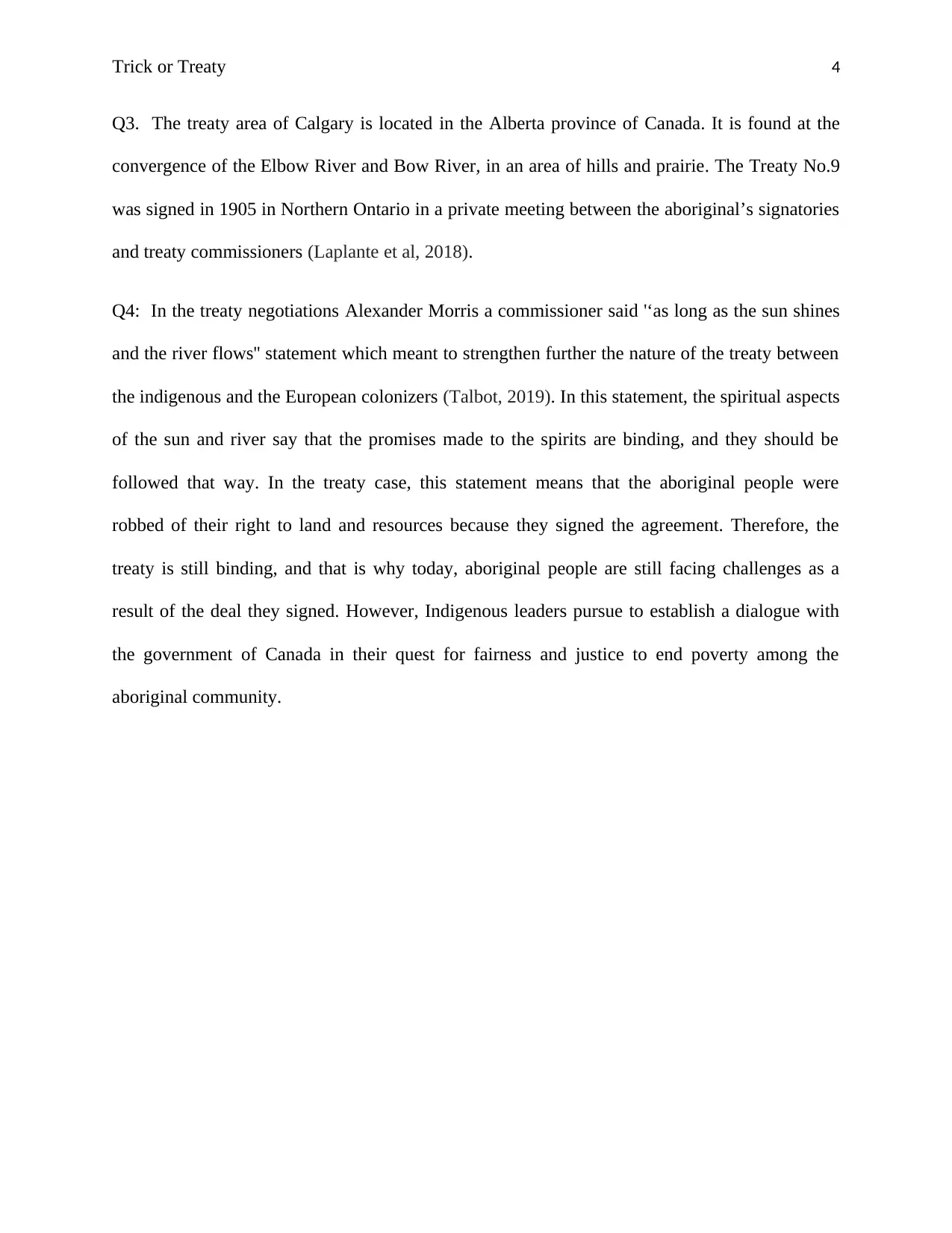
Trick or Treaty 4
Q3. The treaty area of Calgary is located in the Alberta province of Canada. It is found at the
convergence of the Elbow River and Bow River, in an area of hills and prairie. The Treaty No.9
was signed in 1905 in Northern Ontario in a private meeting between the aboriginal’s signatories
and treaty commissioners (Laplante et al, 2018).
Q4: In the treaty negotiations Alexander Morris a commissioner said '‘as long as the sun shines
and the river flows'' statement which meant to strengthen further the nature of the treaty between
the indigenous and the European colonizers (Talbot, 2019). In this statement, the spiritual aspects
of the sun and river say that the promises made to the spirits are binding, and they should be
followed that way. In the treaty case, this statement means that the aboriginal people were
robbed of their right to land and resources because they signed the agreement. Therefore, the
treaty is still binding, and that is why today, aboriginal people are still facing challenges as a
result of the deal they signed. However, Indigenous leaders pursue to establish a dialogue with
the government of Canada in their quest for fairness and justice to end poverty among the
aboriginal community.
Q3. The treaty area of Calgary is located in the Alberta province of Canada. It is found at the
convergence of the Elbow River and Bow River, in an area of hills and prairie. The Treaty No.9
was signed in 1905 in Northern Ontario in a private meeting between the aboriginal’s signatories
and treaty commissioners (Laplante et al, 2018).
Q4: In the treaty negotiations Alexander Morris a commissioner said '‘as long as the sun shines
and the river flows'' statement which meant to strengthen further the nature of the treaty between
the indigenous and the European colonizers (Talbot, 2019). In this statement, the spiritual aspects
of the sun and river say that the promises made to the spirits are binding, and they should be
followed that way. In the treaty case, this statement means that the aboriginal people were
robbed of their right to land and resources because they signed the agreement. Therefore, the
treaty is still binding, and that is why today, aboriginal people are still facing challenges as a
result of the deal they signed. However, Indigenous leaders pursue to establish a dialogue with
the government of Canada in their quest for fairness and justice to end poverty among the
aboriginal community.
Paraphrase This Document
Need a fresh take? Get an instant paraphrase of this document with our AI Paraphraser
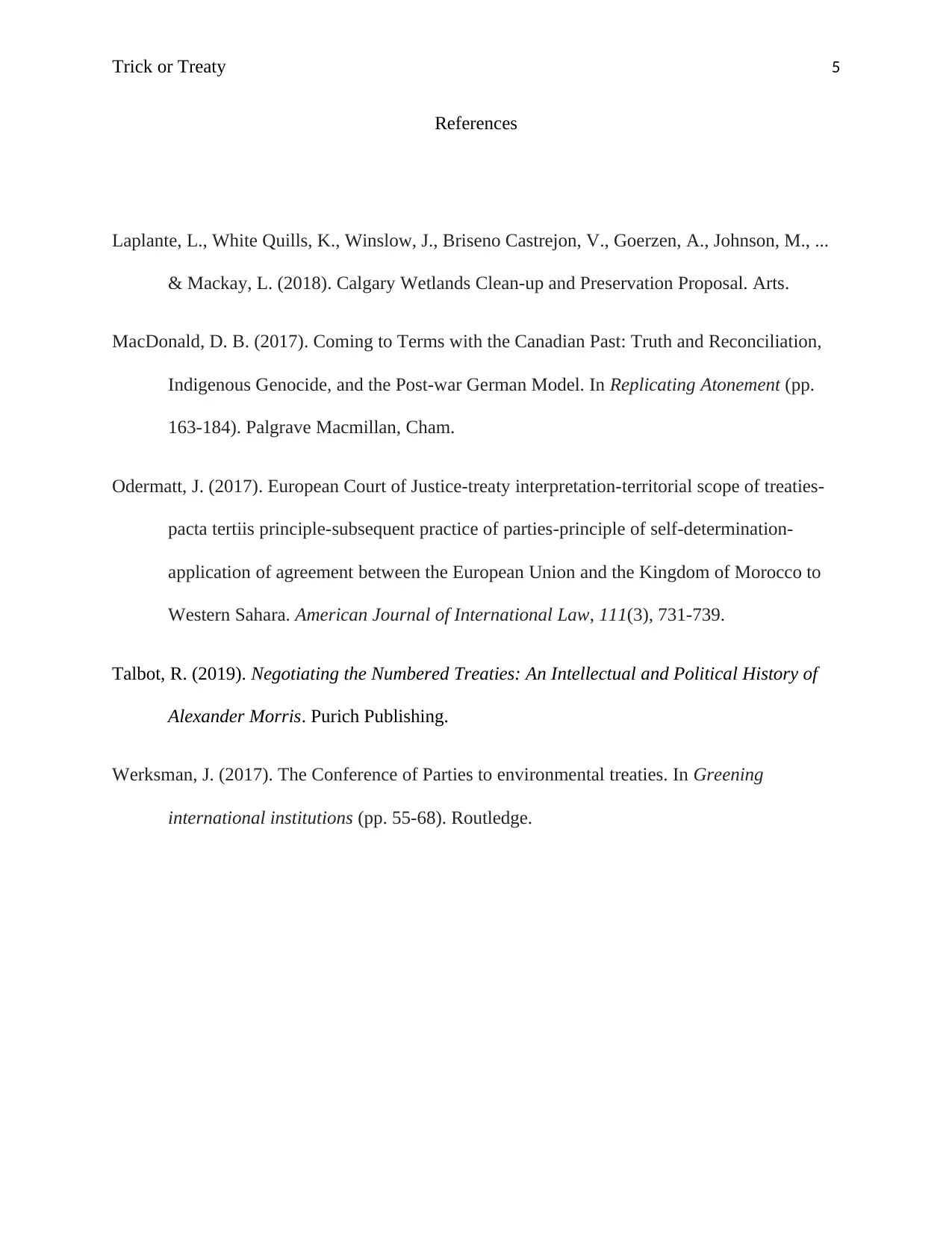
Trick or Treaty 5
References
Laplante, L., White Quills, K., Winslow, J., Briseno Castrejon, V., Goerzen, A., Johnson, M., ...
& Mackay, L. (2018). Calgary Wetlands Clean-up and Preservation Proposal. Arts.
MacDonald, D. B. (2017). Coming to Terms with the Canadian Past: Truth and Reconciliation,
Indigenous Genocide, and the Post-war German Model. In Replicating Atonement (pp.
163-184). Palgrave Macmillan, Cham.
Odermatt, J. (2017). European Court of Justice-treaty interpretation-territorial scope of treaties-
pacta tertiis principle-subsequent practice of parties-principle of self-determination-
application of agreement between the European Union and the Kingdom of Morocco to
Western Sahara. American Journal of International Law, 111(3), 731-739.
Talbot, R. (2019). Negotiating the Numbered Treaties: An Intellectual and Political History of
Alexander Morris. Purich Publishing.
Werksman, J. (2017). The Conference of Parties to environmental treaties. In Greening
international institutions (pp. 55-68). Routledge.
References
Laplante, L., White Quills, K., Winslow, J., Briseno Castrejon, V., Goerzen, A., Johnson, M., ...
& Mackay, L. (2018). Calgary Wetlands Clean-up and Preservation Proposal. Arts.
MacDonald, D. B. (2017). Coming to Terms with the Canadian Past: Truth and Reconciliation,
Indigenous Genocide, and the Post-war German Model. In Replicating Atonement (pp.
163-184). Palgrave Macmillan, Cham.
Odermatt, J. (2017). European Court of Justice-treaty interpretation-territorial scope of treaties-
pacta tertiis principle-subsequent practice of parties-principle of self-determination-
application of agreement between the European Union and the Kingdom of Morocco to
Western Sahara. American Journal of International Law, 111(3), 731-739.
Talbot, R. (2019). Negotiating the Numbered Treaties: An Intellectual and Political History of
Alexander Morris. Purich Publishing.
Werksman, J. (2017). The Conference of Parties to environmental treaties. In Greening
international institutions (pp. 55-68). Routledge.
1 out of 5
Related Documents
Your All-in-One AI-Powered Toolkit for Academic Success.
+13062052269
info@desklib.com
Available 24*7 on WhatsApp / Email
![[object Object]](/_next/static/media/star-bottom.7253800d.svg)
Unlock your academic potential
Copyright © 2020–2025 A2Z Services. All Rights Reserved. Developed and managed by ZUCOL.





